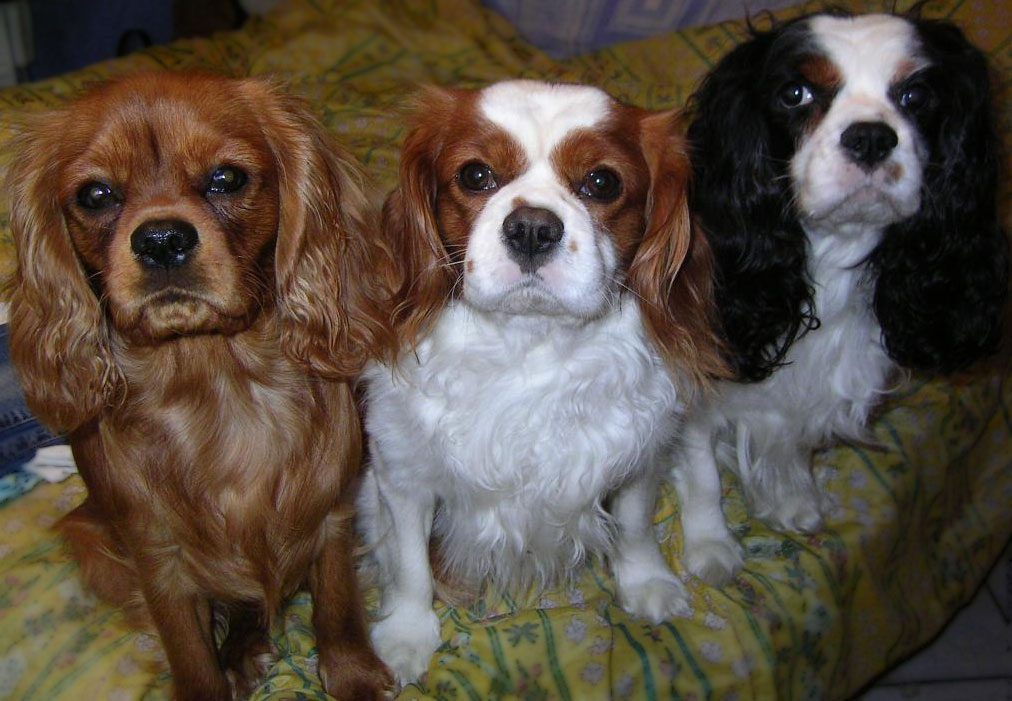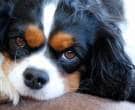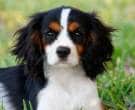Content |
|---|
History Cavalier King Charles Spaniel
The little ones “Spaniels” have been popular companion dogs for hundreds of years. They were found in royal courts and noble houses in Spain (where does the name of the Spaniel), France, England and Scotland, and they were often featured in portraits of their owners. A Scottish Stuarts were especially fond of dogs. Maria, Queen of Scots, she had a toy spaniel by her side when she was executed, to the same as their offspring, King Charles I of England. It was Carlos and his son Carlos II who lent their names to the dogs that eventually became known as the Cavalier King Charles Spaniel.
The popularity of the toy Spaniels began to decline after a new king, Guillermo, replace Jaime II (Stuart also) on the throne of England. William was the Netherlands, and favored the Pug. People began to cross the Pug and Spaniels, and eventually he changed his appearance, becoming flatter with a domed head. Dogs like those seen in old portraits practically disappeared, except for a few lines here and there, such as guarding the Churchill family at Blenheim Palace.
The dogs might have faded into the past except for one Roswell Eldridge, a wealthy American who offered a prize to anyone who could produce a dog like the ones he had seen in 17th and 18th century paintings.
New Spaniels
British breeders accepted the challenge and rebuilt race, working with him English Toy Spaniel long-nosed (called King Charles Spaniels in England). The first of the “new” Spaniels was exhibited in 1928 Crufts Dog Show in. Unfortunately, Eldridge did not live long enough to see, but his estate paid the prize. Since then, the Cavalier has evolved into what it is today: a robust and very popular companion, combining the curiosity of a hunting dog with the affection of a toy dog ​​by people.
The Cavalier ranks 23rd among breeds registered by the American Kennel Club, vs. 54th for the year 2000. This is one of the biggest jumps in popularity in the last decade..
Physical characteristics
Various health issues affect this particular breed, especially the mitral valve disease, leading to heart failure. This will appear in most Cavalier King Charles spaniel at some point in their lives and is the most common cause of death. As well, a high number of specimens usually have a genetic condition called Syringomyelia, which causes the brain to grow in greater proportion than the skull of the dog, i.e. the brain remains tight inside the skull causing havoc neuronal causing severe pain to the animal and uncontrollable tremors.
The measures vary between the different canine federations of the world. But there is a certain consensus that allows us to get an idea of the standard.
The eyes are large, round, well separated in the face. dark brown. The ears are placed high on the head, well separated, they are long with many fringes and moderately long hair (pen). Snout and bite: Slightly cropped. Length of the base of the stop to the tip of the nose must be of a 3,8 cm.. It prefers the Scissor bite. The tail has moderated with long fringe hair length (well defined pen). It keeps it behind the body, rarely higher than the back. It is always her moving when it is in action.
The height at the cross or the shoulders is of 30 to 33 cm and the weight of 4,5 to 8,2 kg.
The life expectancy of a Cavalier King Charles spaniel is of 11 to 12 years. Although there have been documented several cases that have managed to live until the 16 years.
The mantle is composed of soft hair, silky, of moderate length. It may be slightly hondeado. Should not cut you and has to be brushed frequently.
The colors of the mantle of this breed are basically four: Blenheim, Tricolor, ruby, Black and Brown.
- Blenheim: base is White Pearl with well-defined chestnuts marks. The ears are the chestnut.
- Tricolor: base is White Pearl with well defined black markings. The ears are black. On the eyes, cheeks, inside the ears and at the bottom of the tail is brown.
- ruby: The solid reddish brown color is called a ruby.. Is considered a lack if you have white markings.
- Black and Brown: is basic black with Brown markings above the eyes, cheeks, inside of the ears, on the chest, at the bottom of the tail and legs. Is considered a lack if you have white markings.
Character and skills
The Cavalier King Charles spaniel it is small, loving and playful. The typical Cavalier is always happy, confident and carefree, friend of everyone you know. True to its heritage “protective dogs”, to the Cavaliers they love to be on a lap.
The temperament of Cavalier goes from sweet and placid to tough and stubborn. Sweet and placid Cavaliers sometimes have the reputation of being fools, and stubborn for not being trainable, but in general, These dogs are intelligent and learn quickly. They respond well to positive reinforcement techniques, especially when they offered food rewards, but the harsh words will leave them or even try to hide. One Cavalier should never be shy or aggressive towards people or other dogs.
The Cavalier King Charles spaniel, ranks 44 on Stanley Coren's list of "The intelligence of dogs”.
The Cavaliers they live to be with their people. Dogs generally love children and do well in families with older children who throw them a ball, They teach them tricks or just hang out with them. But, due to its small size, the Cavaliers must be protected from clumsy young children who may fall on them or “fondle” too hard.
They love to lick, love to chase moving objects (especially Feathered) and can be manipulative when they want food (those eyes!). It is difficult or impossible to stop these behaviors, so it is necessary to find a way to avoid, how to keep the dog always tied in the cities and be firm when the Cavaliers wants to share the fries.
The Cavaliers is not perfect. any dog, no matter how pleasant it, You may develop obnoxious barking levels, digging and other undesirable behavior if you are bored, untrained or unsupervised.
Training of the Cavalier King Charles Spaniel
Start training your puppy the day you bring him home. Even at eight weeks old, He is able to absorb everything that can be taught. Don't wait until you have 6 months to start training or have to deal with more stubborn dog. If possible, Take it to a trainer so that when it is between 10 and 12 weeks old is a sociable dog. But, Note that many kinds of training puppies require certain vaccinations (such as kennel cough) stay up to date, and many vets recommend limited exposure to other dogs and public places until puppy vaccinations have been completed (including rabies, distemper and parvovirus).
Instead of formal training, you can start training your puppy at home and socialize with family and friends until immunizations are completed for puppies.
Talk to the breeder, Describe exactly what you want in a dog and ask for help choosing a puppy. Breeders see the puppies daily and can make amazingly precise recommendations once they know something about their lifestyle and personality.
Images “Cavalier King Charles spaniel”
Videos “Cavalier King Charles spaniel”
Characteristics “Cavalier King Charles spaniel”
Coexistence is important that you have with your new friend. Before considering the acquisition of a dog of the breed "Cavalier King Charles spaniel" you know certain factors. Not all breeds of dogs are apt to live in an apartment, you must take into account his character, their need for exercise, their interaction with other pets, their care and if you have small children, their level of tolerance towards them.
Adaptation ⓘ5.0 out of 5 stars (based on 1 review)
|
friendly dog ⓘ5.0 out of 5 stars (based on 1 review)
|
hair loss ⓘ3.0 out of 5 stars (based on 1 review)
|
|---|---|---|
Affection level ⓘ5.0 out of 5 stars (based on 1 review)
|
Need for exercise ⓘ3.0 out of 5 stars (based on 1 review)
|
Social need ⓘ5.0 out of 5 stars (based on 1 review)
|
Home ⓘ5.0 out of 5 stars (based on 1 review)
|
Toilet ⓘ3.0 out of 5 stars (based on 1 review)
|
Friendly with strangers ⓘ5.0 out of 5 stars (based on 1 review)
|
barking ⓘ3.0 out of 5 stars (based on 1 review)
|
Health ⓘ4.0 out of 5 stars (based on 1 review)
|
Territorial ⓘ2.0 out of 5 stars (based on 1 review)
|
Cat friendly ⓘ3.0 out of 5 stars (based on 1 review)
|
Intelligence ⓘ4.0 out of 5 stars (based on 1 review)
|
Versatility ⓘ4.0 out of 5 stars (based on 1 review)
|
Child friendly ⓘ3.0 out of 5 stars (based on 1 review)
|
joy ⓘ3.0 out of 5 stars (based on 1 review)
|
Surveillance ⓘ3.0 out of 5 stars (based on 1 review)
|
Breeders of the breed "Cavalier King Charles spaniel"
Type and recognitions:
- FCI CLASSIFICATION: 136
- Group 9: Companion and Toy Dogs
- Section 7: English Toy Spaniels. Without working trial.
Federations:
- – FCI – Group 9: Section 7: English Toy Spaniels ⓘ
- – AKC – Toy ⓘ
- – ANKC – Group 1 (Toy) ⓘ
- – CKC – Group 5 – (Toy) ⓘ
- – KC – Toy ⓘ
- – NZKC – Toy ⓘ
- – UKC – Group 8 – Companion dog ⓘ
FCI breed standard "Cavalier King Charles spaniel"
Alternative names:
1. Cavalier (English).
2. Cavalier (French).
3. Cavalier (German).
4. Cavalier (Portuguese).
5. Cavalier (español).
Images:
-Image by Alexas_FotosenPixabay
– Mario Simoes
– Kfiatek4300 [CC BY-SA 4.0], via Wikimedia Commons
– Bru-no(pixabay.com)









